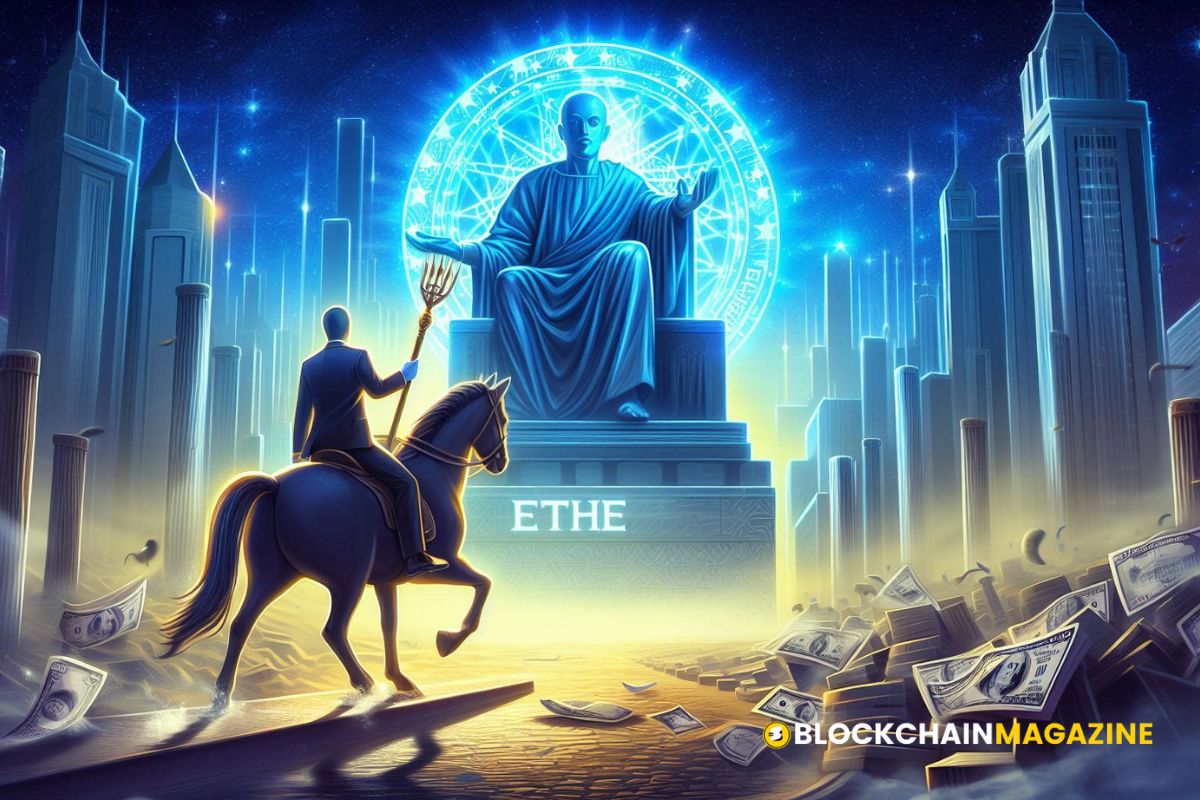Why SOL and XRP Could Be the Next Big Crypto ETFs According to Standard Chartered
Cryptocurrency enthusiasts and investors are always on the lookout for the next big opportunity, and ETFs (Exchange-Traded Funds) have become a significant focus. Recently, Standard Chartered analyst Geoffrey Kendric highlighted that Solana (SOL) and Ripple’s XRP could be potential candidates for ETFs, though this may not materialize until 2025. With the approval of an essential filing in the race to launch a spot ether (ETH) ETF, the crypto community is buzzing with speculation about which digital asset might follow next.
Understanding ETFs
What are ETFs?
Exchange-Traded Funds, or ETFs, are investment funds traded on stock exchanges, much like stocks. They hold assets such as stocks, commodities, or bonds and generally operate with an arbitrage mechanism designed to keep trading close to its net asset value, though deviations can occasionally occur.
Types of ETFs
There are various types of ETFs, but the most relevant for the crypto market are Spot ETFs and Futures ETFs. Spot ETFs directly hold the underlying asset, such as Bitcoin or Ethereum, whereas Futures ETFs are based on derivative contracts.
Read more: Fidelity Reportedly Amends Ether ETF S-1 Filing, Removes ETH Staking
Current Landscape of Crypto ETFs
Bitcoin and Ether ETFs
Currently, the crypto market features Bitcoin and Ether ETFs, which have significantly impacted how investors access and trade these digital assets. The approval of these ETFs by regulatory bodies like the SEC has paved the way for broader market adoption and increased liquidity.
SEC’s Role in ETF Approval
The Securities and Exchange Commission (SEC) plays a crucial role in the approval of ETFs. Their regulatory requirements ensure that ETFs meet specific standards of transparency and investor protection. Recently, the SEC approved forms 19b-4 filed by potential issuers, a critical step towards launching a spot ether ETF.
Read more: ‘Winter is Over’ — Bullishness Returns in Wake of Ether ETF Anticipation
Spot Ether ETF: A Game Changer
Significance of the Approval
The approval of a spot ether ETF marks a significant milestone in the crypto world. It signals a growing acceptance of digital assets within traditional financial markets and offers investors a new way to gain exposure to Ethereum without directly buying the cryptocurrency.
Timeline for Full Approval
Despite this progress, the full approval process could take weeks or even months. The SEC needs to approve the S-1 document, which has so far only been filed by a few issuers, posing a potential delay in the launch of the spot ether ETF.
Why Solana (SOL) and Ripple (XRP)?
Standard Chartered’s Perspective
Standard Chartered’s analyst Geoffrey Kendric believes Solana and Ripple’s XRP could be the next contenders for ETFs. This prediction is based on the technological and market positioning of these cryptocurrencies, suggesting they might follow in Ethereum’s footsteps.
Solana as a Contender
Solana has gained attention due to its technical similarities with Ethereum, such as its smart contract capabilities and high throughput. As the third-largest cryptocurrency by market cap, excluding stablecoins like Tether (USDT) and Binance Coin (BNB), Solana’s robust market position makes it a strong candidate.
Ripple’s Potential
Ripple’s XRP, despite facing legal challenges, remains a significant player in the crypto market. Its potential resolution of legal issues and strong market adoption could position it well for future ETF consideration.
Future Prospects for SOL and XRP ETFs
Expected Timeline for Approval
Standard Chartered suggests that the ETF status for SOL and XRP is likely a 2025 story, not a 2024 one. This timeline allows for the resolution of ongoing legal matters and further market development.
Market Predictions and Trends
Industry experts predict that the approval of ETFs for SOL and XRP could significantly impact their market prices and overall adoption. As seen with Bitcoin and Ether, ETF approvals typically boost investor confidence and market activity.
Comparing SOL and XRP to Bitcoin and Ether
Market Capitalization and Liquidity
Currently, Solana and XRP trail behind Bitcoin and Ether in market capitalization and liquidity. However, their unique technological features and growing communities present opportunities for growth and market expansion.
Technological Advancements
Solana’s high throughput and low transaction costs make it a compelling alternative to Ethereum. Meanwhile, XRP’s focus on facilitating cross-border payments and partnerships with financial institutions highlight its unique value proposition.
Community and Developer Support
Both Solana and XRP boast active developer communities and strong support from investors. Continuous development and innovation within these communities are crucial for maintaining their competitive edge.
SEC’s Regulatory Process
Forms 19b-4 and S-1
The SEC’s approval process involves two critical forms: 19b-4 and S-1. The 19b-4 form is a proposed rule change filed by the exchange, while the S-1 form is the registration statement filed by the issuer. Both are necessary for an ETF to be approved.
Timeline and Expectations
The approval timeline for these forms can vary, influenced by regulatory scrutiny, market conditions, and the thoroughness of the issuers’ compliance efforts. Delays can occur, but the ongoing progress signals positive movement.
Challenges Faced by Issuers
Issuers face numerous challenges, including ensuring compliance with regulatory standards, maintaining transparency, and addressing any market or legal concerns that may arise.
Impact of ETF Approvals on the Crypto Market
Market Reactions to ETF News
Historically, news of ETF approvals has led to positive market reactions, with increased trading volumes and price surges. This trend underscores the market’s enthusiasm for regulated investment vehicles.
Long-term Benefits of ETFs
ETFs bring several long-term benefits to the crypto market, including increased adoption, improved market stability, and greater investor confidence. They also provide a more accessible entry point for traditional investors looking to diversify their portfolios with digital assets.
Conclusion
The potential for Solana (SOL) and Ripple’s XRP to become candidates for ETFs is an exciting development in the crypto world. While the full realization of this possibility might not occur until 2025, the ongoing advancements and regulatory progress set a positive tone for the future. As the market continues to evolve, keeping an eye on these developments will be crucial for investors and enthusiasts alike.
FAQs
- What is an ETF and how does it work? An ETF, or Exchange-Traded Fund, is an investment fund traded on stock exchanges that holds assets like stocks, commodities, or bonds. It allows investors to buy shares representing a portion of these assets, providing diversification and ease of trading.
- Why is the approval of a spot ether ETF significant? The approval of a spot ether ETF is significant because it represents a growing acceptance of digital assets in traditional financial markets. It offers investors a regulated and straightforward way to gain exposure to Ethereum, potentially increasing market stability and adoption.
- Why are SOL and XRP considered for future ETFs? SOL and XRP are considered for future ETFs due to their strong market positions, technological advancements, and growing communities. Standard Chartered analysts believe these assets have the potential to follow in the footsteps of Bitcoin and Ether, gaining broader acceptance and regulatory approval.
- What challenges do issuers face in getting ETF approval? Issuers face challenges such as meeting regulatory standards set by bodies like the SEC, ensuring compliance and transparency, and navigating market conditions. They must file and get approval for forms like 19b-4 and S-1, which can be a lengthy and detailed process.
- How will ETF approvals impact the overall crypto market? ETF approvals typically lead to increased market activity, higher investor confidence, and greater adoption of the underlying assets. They provide a regulated investment vehicle that can attract traditional investors, contributing to market growth and stability.
Stay informed with daily updates from Blockchain Magazine on Google News. Click here to follow us and mark as favorite: [Blockchain Magazine on Google News].
Get Blockchain Insights In Inbox
Stay ahead of the curve with expert analysis and market updates.
latest from tech
Disclaimer: Any post shared by a third-party agency are sponsored and Blockchain Magazine has no views on any such posts. The views and opinions expressed in this post are those of the clients and do not necessarily reflect the official policy or position of Blockchain Magazine. The information provided in this post is for informational purposes only and should not be considered as financial, investment, or professional advice. Blockchain Magazine does not endorse or promote any specific products, services, or companies mentioned in this posts. Readers are encouraged to conduct their own research and consult with a qualified professional before making any financial decisions. The featured image used is just a creative depiction of the title and it does not intend to hurt sentiments of any person or institution. If it hurts anyone sentiments, please do not hesitate to reach out to Blockchain Magazine.

 Bitcoin
Bitcoin  Ethereum
Ethereum  XRP
XRP  Tether
Tether  Solana
Solana  USDC
USDC  Dogecoin
Dogecoin  Cardano
Cardano  Lido Staked Ether
Lido Staked Ether  TRON
TRON  Chainlink
Chainlink  Wrapped Bitcoin
Wrapped Bitcoin  Sui
Sui  Wrapped stETH
Wrapped stETH  Avalanche
Avalanche  Stellar
Stellar  Hedera
Hedera  Toncoin
Toncoin  Shiba Inu
Shiba Inu  LEO Token
LEO Token  Hyperliquid
Hyperliquid  Bitget Token
Bitget Token  WETH
WETH  Litecoin
Litecoin  USDS
USDS  Polkadot
Polkadot  Bitcoin Cash
Bitcoin Cash  Ethena USDe
Ethena USDe  MANTRA
MANTRA  Wrapped eETH
Wrapped eETH  Uniswap
Uniswap  Ondo
Ondo  Pepe
Pepe  Aave
Aave  Monero
Monero  NEAR Protocol
NEAR Protocol  WhiteBIT Coin
WhiteBIT Coin  Mantle
Mantle  Aptos
Aptos  Dai
Dai  Official Trump
Official Trump  Internet Computer
Internet Computer  Ethereum Classic
Ethereum Classic  Bittensor
Bittensor  Cronos
Cronos  OKB
OKB  POL (ex-MATIC)
POL (ex-MATIC)  Gate
Gate 




